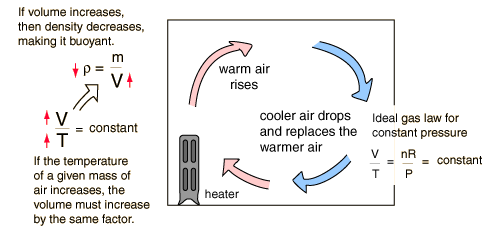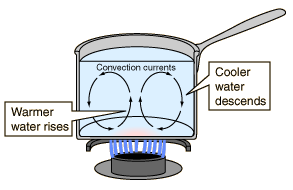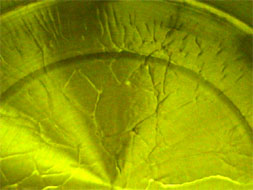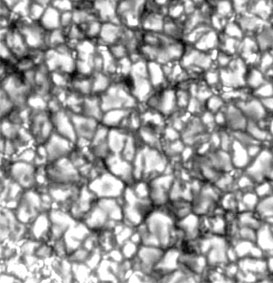Heat Convection
Convection is heat transfer by mass motion of a fluid such as air or water when the heated fluid is caused to move away from the source of heat, carrying energy with it. Convection above a hot surface occurs because hot air expands, becomes less dense, and rises. Hot water is likewise less dense than cold water and rises, causing convection currents which transport energy.

Convection can also lead to circulation in a liquid, as in the heating of a pot of water over a flame. Heated water expands and becomes more buoyant. Cooler, more dense water near the surface descends and patterns of circulation can be formed, though they will not be as regular as suggested in the drawing.

Convection cells are visible in the heated cooking oil in the pot at left. Heating the oil produces changes in the index of refraction of the oil, making the cell boundaries visible. Circulation patterns form, and presumably the wall-like structures visible are the boundaries between the circulation patterns.

Convection is thought to play a major role in transporting energy from the center of the Sun to the surface, and in movements of the hot magma beneath the surface of the earth. The visible surface of the Sun (the photosphere) has a granular appearance with a typical dimension of a granule being 1000 kilometers. The image at right is from the NASA Solar Physics website and is credited to G. Scharmer and the Swedish Vacuum Solar Telescope. The granules are described as convection cells which transport heat from the interior of the Sun to the surface.

In ordinary heat transfer on the Earth, it is difficult to quantify the effects of convection since it inherently depends upon small nonuniformities in an otherwise fairly homogeneous medium. In modeling things like the cooling of the human body, we usually just lump it in with conduction.
Natural convection
Nu = C(Gr.Pr) n C and n are tabled below
Note: Convection heat transfer values are very specific to the geometry of the surface and the heat transfer conditions - These example equations are very general in nature and should not be used for serious calcs. The links below provide much safer equations..
| Surface |
(Gr.Pr) |
C |
n |
| Vertical Plates/Cylinders |
10 4 to 10 9 |
0.59 |
0.25 |
| 10 9 to 10 12 |
0.13 |
0.33 |
| Horizontal Pipes |
10 3 to 10 9 |
0.53 |
0.25 |
Horizontal Plates
Heated Face up or Cooled Face Down |
10 5 to 2 x 10 7 |
0.54 |
0.25 |
| 2 x10 7 to 3 x10 10 |
0.14 |
0.33 |
Horizontal Plates
Heated Face up or Cooled Face Down |
3 x10 5 to 3 x10 10 |
0.27 |
0.25 |
Forced Convection
Laminar flow over Plate Nu = 0,664(Re) 1/2(Pr) 1/3
Fully Developed pipe flow Nu = 3,66 + 0,0866(D/L)Re.Pr / (1+0.04[D / L(Re.Pr)] 2/3)
Turbulent Flow Over Flat Plate Nu = 0,036Pr 1/3Re 0.8
Turbulent Flow In Pipe Nu = 0,023Pr 0.4Re 0.8
D = Diameter, L = Length, mean film temperature properties assumed
Typical Values of Heat Transfer Coefficient h = W.m -2K -1
|
